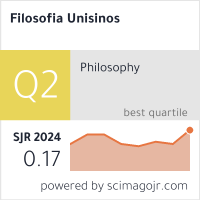Philosophical & Natural: The double identity of causation in the Hume’s Treatise
DOI:
https://doi.org/10.4013/fsu.2012.132.02Resumen
In his theory of relations, Hume classifies two kinds of them, viz. natural and philosophical relations. However, he is not concerned about explaining adequately his criteria for classifying a relation as natural or philosophical. In one of his rare statements about this issue in the Treatise of Human Nature (1739), he suggests that the relation of cause and effect, in particular, can be classified as both a philosophical and a natural relation. By putting together passages like this, I aim to reconstruct Hume’s theory of relations of cause and effect, starting from the long argument he develops in almost the whole third part of the first book of the Treatise. I interpret this argument as the foundation of the possibility and, especially, the necessity of moving between these two ways of classifying causality, i.e. from its initial condition as a philosophical relation to its condition as a natural relation. Given this twofold definition of causation, my goal is also to identify a pragmatic justification for the permanence of the philosophical definition of causation, even though, according to Hume himself, it is conceptually precarious and partial. I argue that the rules for judging cause and effect, strategically placed at the end of the long argument for the naturalization of causality, partially include that justification. Finally, on the basis of this double foundation of causality (viz. as natural and philosophical, as conceptual and pragmatic), I suggest a reinterpretation of Hume’s view of causality as mere regularity, without giving up the criticism addressed to it by Kemp Smith and his followers.
Key words: causality, Hume, David (1711-1776), relations, induction, pragmatics of inquiry.
Descargas
Descargas
Publicado
Cómo citar
Número
Sección
Licencia
Concedo a revista Filosofia Unisinos – Unisinos Journal of Philosophy o direito de primeira publicação da versão revisada do meu artigo, licenciado sob a Licença Creative Commons Attribution 4.0 (que permite o compartilhamento do trabalho com reconhecimento da autoria e publicação inicial nesta revista).
Afirmo ainda que meu artigo não está sendo submetido a outra publicação e não foi publicado na íntegra em outro periódico e assumo total responsabilidade por sua originalidade, podendo incidir sobre mim eventuais encargos decorrentes de reivindicação, por parte de terceiros, em relação à autoria do mesmo.










